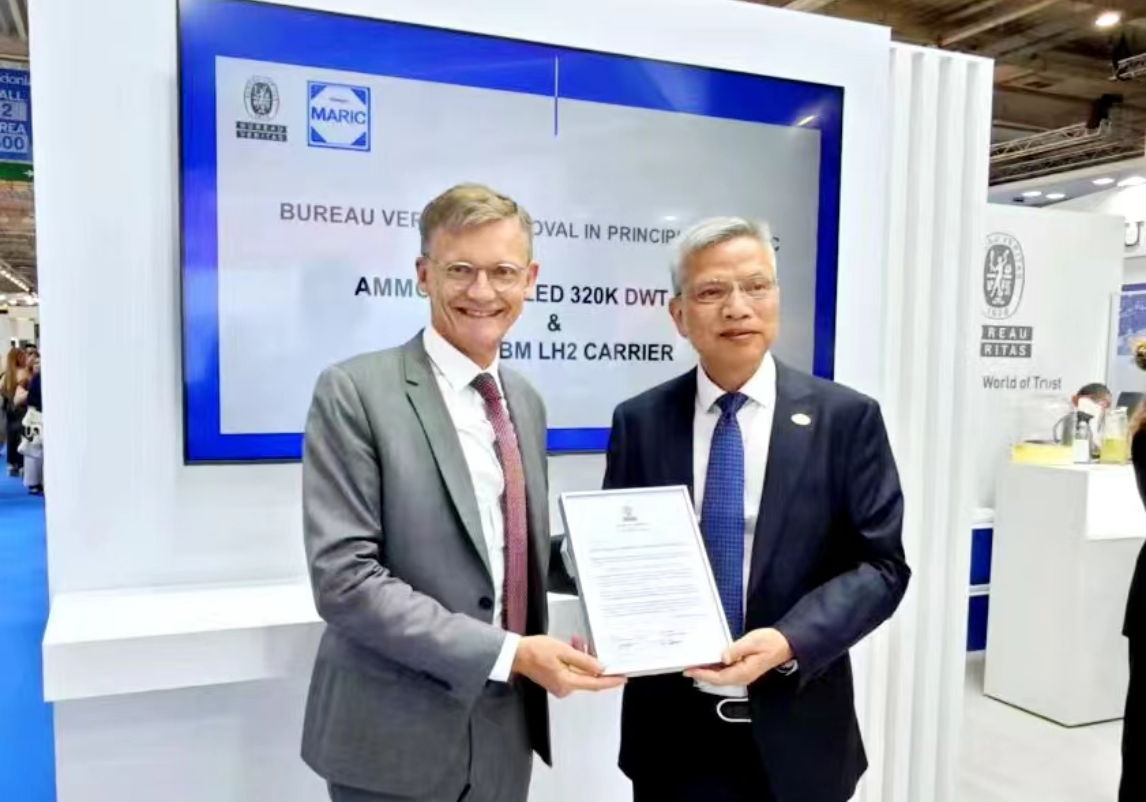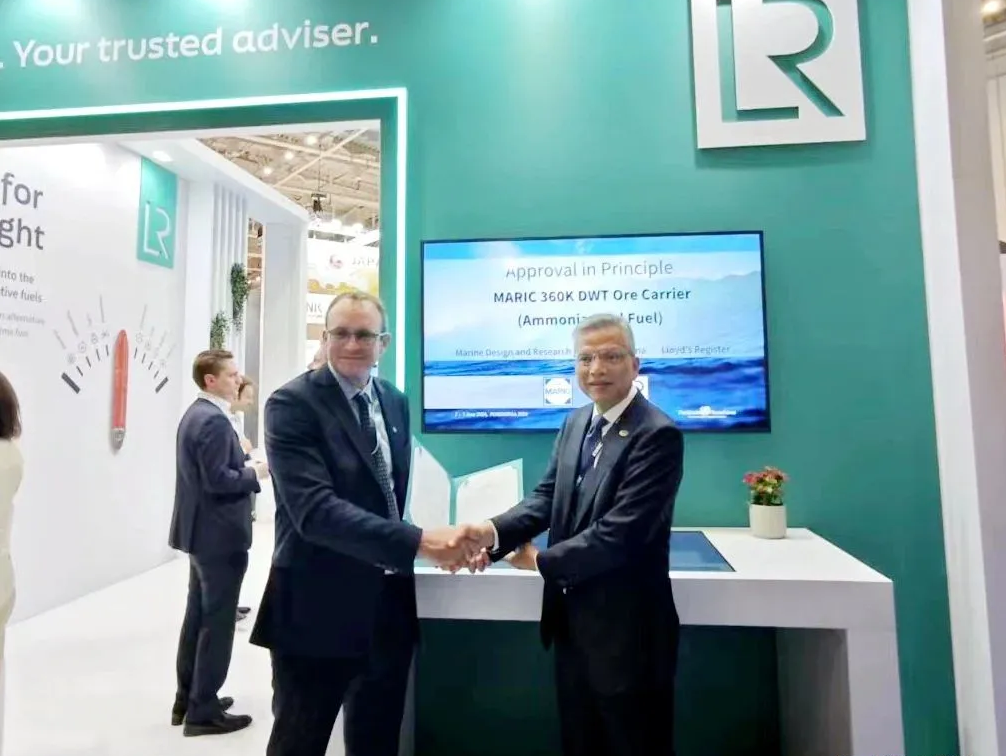On June 4, five high-quality ships, including the world’s largest ammonia dual-fuel powered pure car and track carrier (PCTC), independently developed by China State Shipbuilding Corporation’s (CSSC) Marine Design and Research Institute of China (MARIC), were awarded Approval-in-Principle (AiP) certificates issued by Lloyd’s Register of Shipping (LR), American Bureau of Shipping (ABS), and Bureau Veritas (BV) respectively, at the Posidonia 2024 maritime event held in Athens. It demonstrates the strong innovation capability of MARIC in leading the industry in the field of green and low-carbon ship research and development.
The world’s largest 180,000 m³-class liquefied natural gas (LNG) dual-fuel powered liquid hydrogen carrier and 12,800 CEU ammonia dual-fuel powered ultra-large PCTC, which have attracted much attention, were awarded AIP certificates by BV and LR respectively.
Among them, the 180,000 m³-class LNG dual-fuel powered liquid hydrogen carrier, with an overall length of 315 meters and a beam of 54 meters, is a new vessel developed by MARIC specifically for high-volume cross-border trade of liquid hydrogen.

It adopts double-layer vacuum spherical tanks with vacuum and insulation filling between two layers, the evaporation rate is controlled to be 0.1%, and the volume of a single tank reaches 45,000 m³. The vessel adopts deep V-shaped hull in order to increase the draft as much as possible, and the design draft is designed to be 10 meters. The living building is set up at the bow, and the windshield is set up at the front to reduce the wind resistance.
The vessel is powered by either diesel or LNG dual-fuel main engines, with fuel tanks arranged in the bow area. The engine room area is equipped with Proton Exchange Membrane (PERM) fuel cell, the evaporated hydrogen is supplied to the PERM fuel cell to produce electricity, and two additional diesel/LNG dual fuel generators are equipped to meet the demand of loading and unloading cargo power distribution.
The 12,800 CEU PCTC has received AIP certificate from LR. The PCTC is a new generation of oversized and environmentally friendly Ro-Ro carrier which is designed to meet the growing demand for commercial car transportation. It adopts advanced green ammonia fuel power system, integrating solar energy, batteries and other energy sources, which can reduce greenhouse gas emissions by 89% compared with fuel oil. Compared with the previous generation of 9000/10,000 CEU class PCTC, the daily fuel consumption increases only slightly despite the significant increase in the number of loaded vehicles, and the effective loading capacity and space utilization rate of the PCTC have been greatly improved.
The PCTC is set up with multi-layer lifting decks, which can satisfy the loading of various kinds of ultra-high, super-heavy and other large vehicles, and can also be flexibly adjusted in accordance with the loading requirements of different vehicles, so as to maximize the transportation capacity and space utilization rate.
It is capable of loading new energy vehicles with various powers, such as lithium battery, hydrogen, natural gas, etc., to meet the growing demand for new energy transportation. It is equipped with an efficient and flexible ro-ro handling system, which can meet the rapid and safe loading and unloading of multi-layer vehicles at the same time. Particularly, this PCTC is also featured in a variety of different versions, including conventional fuel, LNG, and methanol dual-fuel, providing users with a wide range of different solutions.
The 150,000m3 Ultra Large Ethane Carrier (ULEC) has received AIP certificate from ABS. With an overall length of 274 meters and a beam of 42 meters, the ULEC is powered by a ME-GIE ethane dual-fuel main engine with a single propeller drive, which is the world’s largest liquefied ethane carrier with the largest cargo tank volume developed so far. This ULEC is compatible with both Type B cargo tanks and Mark III membrane tanks as cargo containment systems, featuring low evaporation rate (BOR), low unloading residue, high space utilization, and compatibility with ethylene, propylene and LPG loading.

Its hull lines, propellers and rudders are deeply optimized for ultra-high fuel (gas) efficiency. It meets the scale requirements for berthing at all major U.S. ethane export terminals and navigating the Panama Canal. Configured with a variety of energy-saving devices, it is a green and environmentally friendly ethane carrier with high cargo capacity, low evaporation rate, low energy consumption, high reliability, and excellent versatility and economy.
The 320,000 dwt Malacca’s largest ammonia dual-fuel powered Very Large Crude Carrier (VLCC) has been awarded the AIP certificate by BV. With a length of 339 meters and a breadth of 62 meters, the VLCC is propelled by a single engine and single propeller, equipped with an ammonia dual-fuel main engine, which meets the requirements of unlimited navigation area.

The ammonia fuel tanks are semi-cooled and semi-pressurized, and the main deck is equipped with two C-type independent liquid tanks made of carbon manganese steel, each with a capacity of about 6,000 m³, with a range of up to 18,000 nautical miles, which can meet the round-trip voyage on the China-Middle East route. In addition, this VLCC is characterized by low fuel consumption and high capacity, and has adopted various energy-saving measures. Especially under the limited draft of Malacca Strait, the carrying capacity is 20,000 tons higher than the conventional VLCC, featuring significant shallow draft economy.
The 360,000 DWT Very Large Ore Carrier (VLOC) received AIP certificate from LR. This VLOC is an ocean-going ore carrier with liquid-ammonia dual-fuel power main engine and strong cargo carrying capacity. In addition to iron ore, it can also carry full load of bauxite and is suitable for Brazil and West Africa routes.

The VLOC is fitted with two C-type ammonia fuel tanks and fuel preparation rooms on the deck in the corresponding areas. The fuel refueling stations are open and have special protection on the top to prevent the cargo from falling. All ammonia fuel systems are located away from the living areas to provide effective isolation from toxic gases. It is dual-fueled with liquid ammonia and has an optional open scrubber tower to reduce fuel costs. It is fitted with a variety of energy-saving devices and incorporates a number of smart ship elements in its design.
MARIC actively carries out key technology researching on green vessels, intelligent vessels, polar vessels, etc., and has successively launched a full series of dual-fuel propulsion solutions for container vessels, bulk carriers, petrochemical carriers, gas carriers, etc., and continues to optimize them. MARIC also closely tracks new technologies such as marine hydrogen energy equipment, ammonia/methanol and other alternative fuels, and carries out research on equipment technology systems, overall conceptual programs, and key systems for alternative fuel propulsion, and it has become an important force in leading the development of green ship technology in China’s shipbuilding industry.


